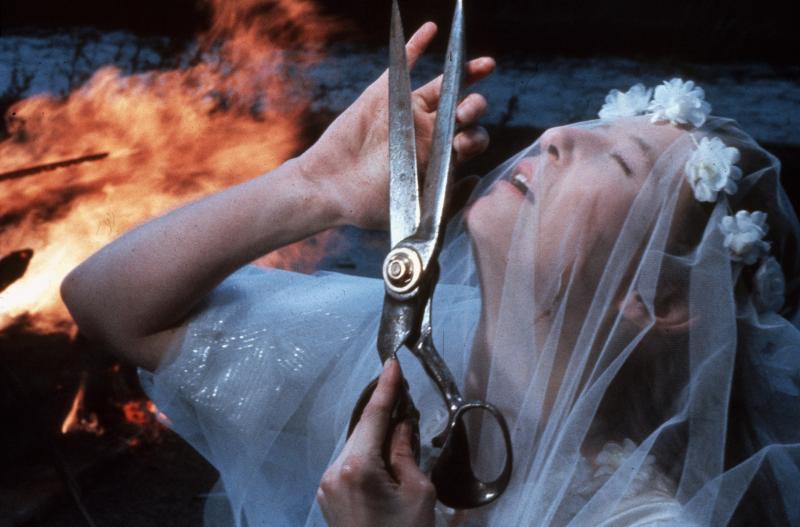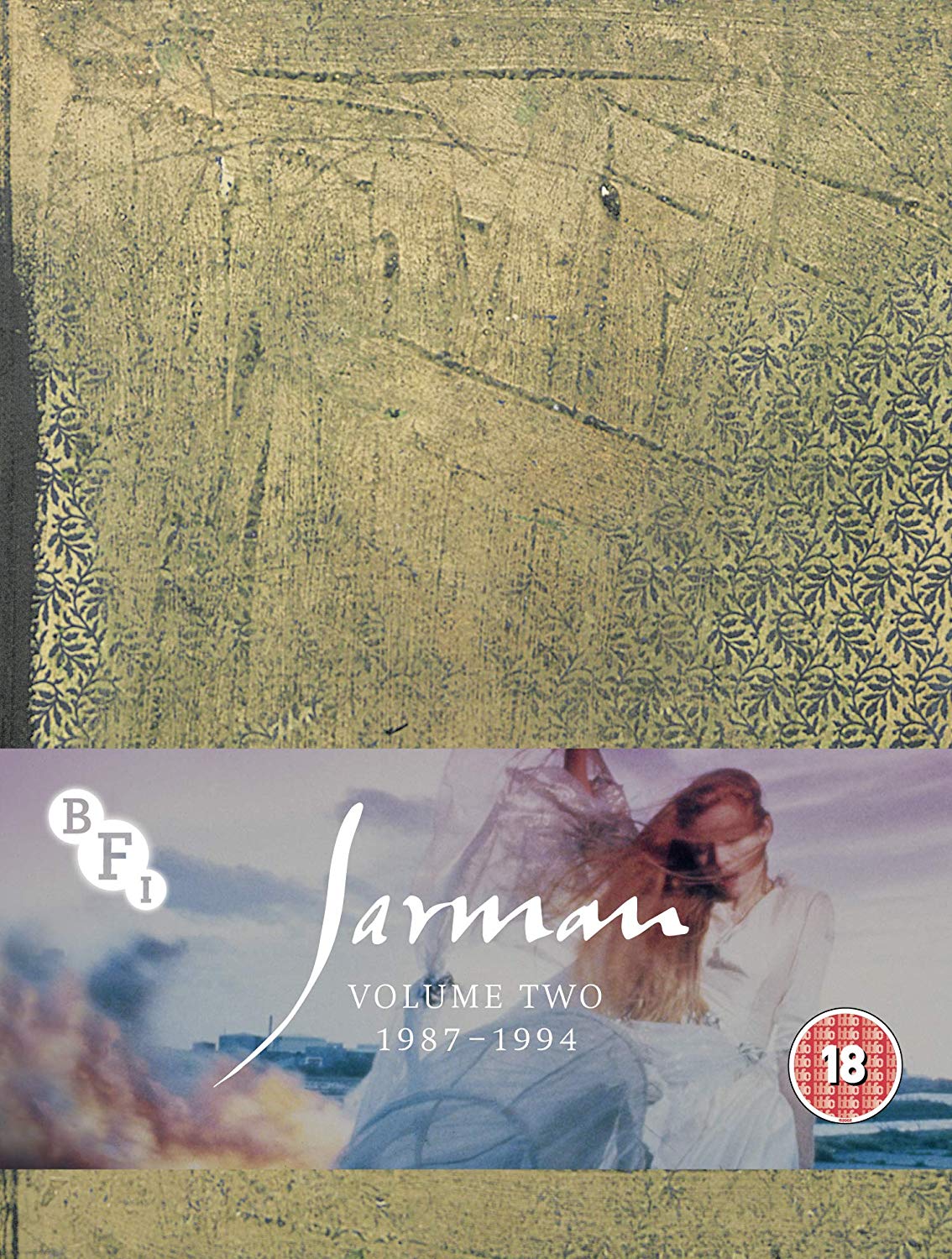Blu-ray: Derek Jarman Collection, Vol Two 1987-1994 | reviews, news & interviews
Blu-ray: Derek Jarman Collection, Vol Two 1987-1994
Blu-ray: Derek Jarman Collection, Vol Two 1987-1994
A very English saint canonised by the BFI

Derek Jarman has always been described as irreverent, but, paradoxically, he is treated today with unreserved and probably excessive reverence. In the church of the avant-garde, and it’s perhaps not completely out of order to suggest that such an institution exists, he has been well and truly sanctified.
Volume Two of the BFI’s monumental and impressive edition of Jarman’s video and film work will add to his status as genius and martyr. This lovingly assembled collection completes a remarkable account of the director’s work with the moving image, an extraordinary oeuvre as he was also writing, painting and campaigning – not to speak of many nights of pleasure and fun – throughout his adult life. AIDS didn’t slow him down: if anything, it gave an urgency to this most prolific of artists, and an energy that enabled him to produce a torrent of wide-ranging work.
 The films include The Last of England (1987), War Requiem (1989), The Garden (1990), Edward II (1991), Wittgenstein (1993), Blue (1993) and the posthumous assembly of Jarman’s Super-8 footage Glitterbug (1994). War Requiem, done in a hurry (two months) isn’t his best work: it’s as if he were trying too hard, his often rather literal inventions not fully realised and drawing in too many disparate strands. These elements fail to resonate poetically, as they do in The Last of England, a work much longer in gestation, with a finely crafted stream of consciousness that mixes politics, alchemical imagery, Derek’s beautiful text, and a great deal of violence and nudity. With Britten's oratorio, what might have been a masterwork falls short of the maturity and reflection the subject deserves.
The films include The Last of England (1987), War Requiem (1989), The Garden (1990), Edward II (1991), Wittgenstein (1993), Blue (1993) and the posthumous assembly of Jarman’s Super-8 footage Glitterbug (1994). War Requiem, done in a hurry (two months) isn’t his best work: it’s as if he were trying too hard, his often rather literal inventions not fully realised and drawing in too many disparate strands. These elements fail to resonate poetically, as they do in The Last of England, a work much longer in gestation, with a finely crafted stream of consciousness that mixes politics, alchemical imagery, Derek’s beautiful text, and a great deal of violence and nudity. With Britten's oratorio, what might have been a masterwork falls short of the maturity and reflection the subject deserves.
When I interviewed Tilda Swinton for an ARENA portrait of Jarman in 1990, she said that “it’s when he’s fizzing with anger that Derek is at his most Jarmanesque”. Beyond the camp and the in-jokes, there is in all these films a great fury and political engagement – not least in perhaps the best film of all from his later years, Edward II. As with Caravaggio or the witty and inventive Wittgenstein, Jarman’s narrative-driven films benefit from tiny budgets: the absence of elaborate sets, and the creation of a world which allows the imagination to fill in the gaps that would have been covered by a more naturalistic setting, create a powerful intensity and forces the inner drama to the surface. In Edward II, the camera work by Ian Wilson, the sets by Christopher Hobbs and Sandy Powell’s costumes work perfectly. All in the service of the fierce and unrelenting anger that drove Derek to exploit the narrative of the king’s passion for Piers Gaveston and the struggle with his wife and barons as an historically revisionist clarion call for the fight against homophobia in the Britain of Clause 28.
There will come a time when talking or writing about Derek Jarman goes beyond the generally hagiographic parade of collaborators, friends and experts who are included in a magnificently rich collection of bonuses: Tilda Swinton, set designer Christopher Hobbs, producer James Mackay, composer Simon Fisher Turner, costume designer Sandy Powell, director John Maybury are just some of the people who have been interviewed especially for this box set. They speak eloquently and fondly of Derek: of his working methods, the infectious and child-like enthusiasm with which he could energise those who worked alongside him. Artist-filmmaker John Scarlett-Davis speaks amusingly of chaperoning Jarman on his visits to gay clubs and Hampstead Heath, alluding to a vast sexual appetite and voyeuristic fascination with S&M that mirrored his relentless creative energy. “Sex”, Scarlett-Davis concludes, ”was the machine that drove him.”
There was something beguiling about Derek’s often naïve lack of boundaries and his rebellion against all kinds of form
Apart from the copious selection of interviews, there are many other interesting items, including Dead Cat (1989), a surrealist visual poem of homo-eroticism and violence with cameos from Jarman and Genesis P-Orridge; David Lewis’s film The Wanderer (1991), based on an Anglo-Saxon poem; an enchanting interview with Jarman at his most charming, for a Thames TV programme Book at My Bedside, where he talks about Bachelard and Heraclitus, evoking the eclecticism of his reading. There's also a great deal of audio, including a 70-minute interview with Colin McCabe; a selection of unused sounds and music from Simon Fisher Turner; and Bliss (1991), the 40-minute piece that would grow into Blue (1993). There is also a beautifully produced and very full 100-page booklet, with photos, essays and a fascinating transcript of Tilda Swinton's tremendous first Derek Jarman Memorial Lecture at the Edinburgh Film Festival in 2002. Of all the collaborators, it is she who understands best the richness and paradox in Jarman's oeuvre: her closeness to Derek over the years enables her to be both generous and critical, loving and detached.
Blue is still a daring work, courageous on a personal level, but also artistically. A deeply moving film in which you create the images yourself, as John Maybury says in one of his interviews, as you listen and the blue screen allows your inner eye to open. There was something beguiling about Derek’s often naïve lack of boundaries and his rebellion against all kinds of form. The mix of nostalgia for an imagined and untainted heritage Britain with a punkish dedication to demolishing the symbols and institutions of the established order is symptomatic of the contradictions and paradoxes that run through the work.
The rebellion becomes after a while a little tiresome, bound as it is to an almost masochistic obsession with the often lurid and cartoon-like images of authority, power and violence, that colour Jarman’s take on eroticism and sexuality. This box-set demonstrates the paradoxes at the heart of this dance between love and hate, dominatrixes and slaves, rebellion and tyranny, freedom and addiction, but for all the talk assembled in a massive array of bonuses, there is barely anything that discusses with any depth the darker or more problematic aspects of Jarman’s work.
rating
Explore topics
Share this article
The future of Arts Journalism
You can stop theartsdesk.com closing!
We urgently need financing to survive. Our fundraising drive has thus far raised £49,000 but we need to reach £100,000 or we will be forced to close. Please contribute here: https://gofund.me/c3f6033d
And if you can forward this information to anyone who might assist, we’d be grateful.

Subscribe to theartsdesk.com
Thank you for continuing to read our work on theartsdesk.com. For unlimited access to every article in its entirety, including our archive of more than 15,000 pieces, we're asking for £5 per month or £40 per year. We feel it's a very good deal, and hope you do too.
To take a subscription now simply click here.
And if you're looking for that extra gift for a friend or family member, why not treat them to a theartsdesk.com gift subscription?
more Film
 London Film Festival 2025 - a Korean masterclass in black comedy and a Camus classic effectively realised
New films from Park Chan-wook, Gianfranco Rosi, François Ozon, Ildikó Enyedi and more
London Film Festival 2025 - a Korean masterclass in black comedy and a Camus classic effectively realised
New films from Park Chan-wook, Gianfranco Rosi, François Ozon, Ildikó Enyedi and more
 After the Hunt review - muddled #MeToo provocation
Julia Roberts excels despite misfiring drama
After the Hunt review - muddled #MeToo provocation
Julia Roberts excels despite misfiring drama
 London Film Festival 2025 - Bradley Cooper channels John Bishop, the Boss goes to Nebraska, and a French pandemic
... not to mention Kristen Stewart's directing debut and a punchy prison drama
London Film Festival 2025 - Bradley Cooper channels John Bishop, the Boss goes to Nebraska, and a French pandemic
... not to mention Kristen Stewart's directing debut and a punchy prison drama
 Ballad of a Small Player review - Colin Farrell's all in as a gambler down on his luck
Conclave director Edward Berger swaps the Vatican for Asia's sin city
Ballad of a Small Player review - Colin Farrell's all in as a gambler down on his luck
Conclave director Edward Berger swaps the Vatican for Asia's sin city
 London Film Festival 2025 - from paranoia in Brazil and Iran, to light relief in New York and Tuscany
'Jay Kelly' disappoints, 'It Was Just an Accident' doesn't
London Film Festival 2025 - from paranoia in Brazil and Iran, to light relief in New York and Tuscany
'Jay Kelly' disappoints, 'It Was Just an Accident' doesn't
 Iron Ladies review - working-class heroines of the Miners' Strike
Documentary salutes the staunch women who fought Thatcher's pit closures
Iron Ladies review - working-class heroines of the Miners' Strike
Documentary salutes the staunch women who fought Thatcher's pit closures
 Blu-ray: The Man in the White Suit
Ealing Studios' prescient black comedy, as sharp as ever
Blu-ray: The Man in the White Suit
Ealing Studios' prescient black comedy, as sharp as ever
 The Woman in Cabin 10 review - Scandi noir meets Agatha Christie on a superyacht
Reason goes overboard on a seagoing mystery thriller
The Woman in Cabin 10 review - Scandi noir meets Agatha Christie on a superyacht
Reason goes overboard on a seagoing mystery thriller
 London Film Festival 2025 - crime, punishment, pop stars and shrinks
Daniel Craig investigates, Jodie Foster speaks French and Colin Farrell has a gambling habit
London Film Festival 2025 - crime, punishment, pop stars and shrinks
Daniel Craig investigates, Jodie Foster speaks French and Colin Farrell has a gambling habit
 I Swear review - taking stock of Tourette's
A sharp and moving tale of cuss-words and tics
I Swear review - taking stock of Tourette's
A sharp and moving tale of cuss-words and tics
 A House of Dynamite review - the final countdown
Kathryn Bigelow's cautionary tale sets the nuclear clock ticking again
A House of Dynamite review - the final countdown
Kathryn Bigelow's cautionary tale sets the nuclear clock ticking again

Add comment